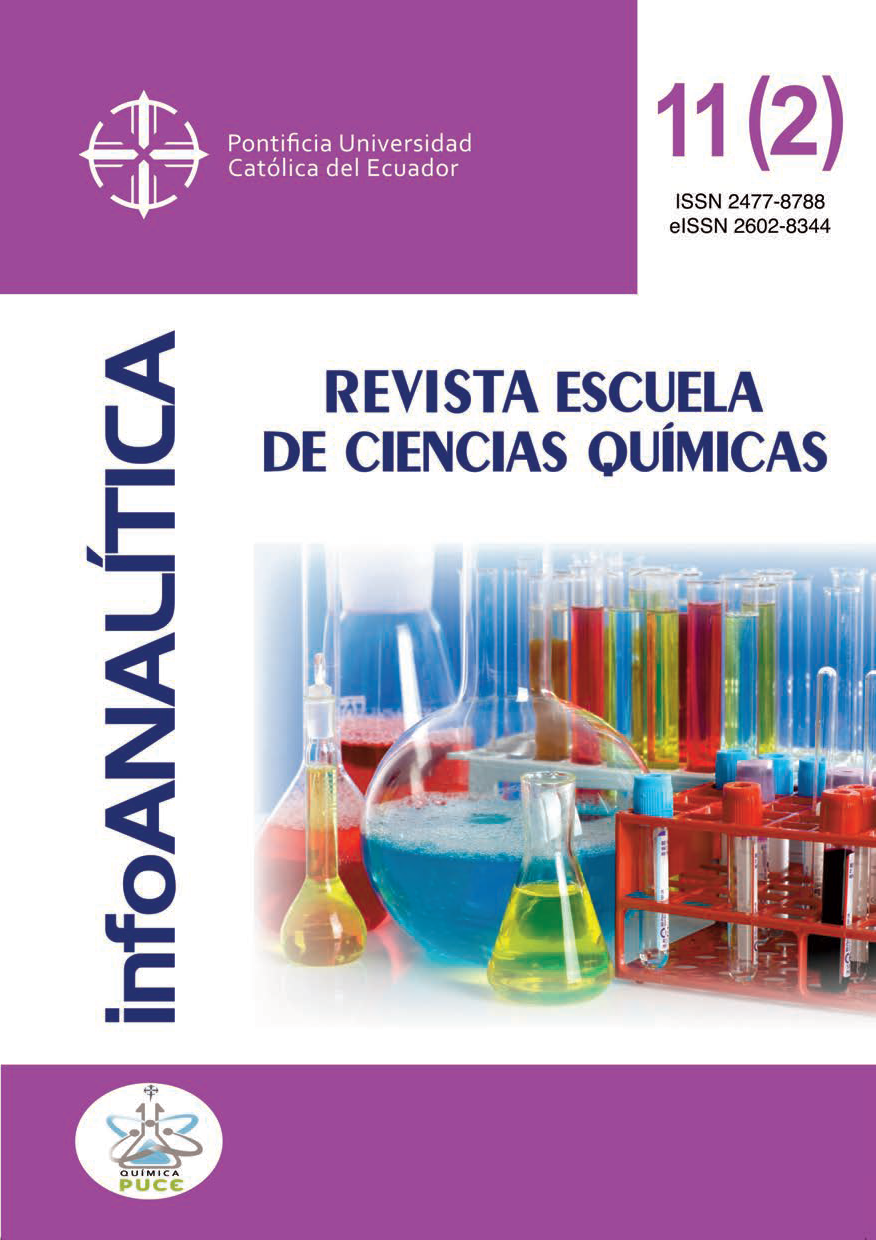EVALUATION OF CURCUMINOIDS, POLYPHENOLS AND ANTIOXIDANT CAPACITY IN RESIDUES FROM THE DISTILLATION PROCESS OF ESSENTIAL OILS OF CURCUMA LONGA L.
Main Article Content
Abstract
Agro-industrial wastes produced in various extractive processes cause and exacerbate environmental problems. One process that generates thousands of tons of biomass annually is the distillation of essential oils, where small quantities of the oil and high amounts of waste are obtained. Turmeric essential oil is marketed all over the planet. In the process, a residual cake is produced that is often discarded without considering the secondary metabolites that can still be reused. This research quantifies the remaining curcuminoids and polyphenols in the residual cake and their antioxidant activity by spectrophotometric methods. Concerning the presence of secondary metabolites, it is valid to highlight the concentration of
curcuminoids still preserved in the residue because these are not significantly affected in the distillation process and therefore maintain a concentration of 51.750 ± 0.060 mg/g, considering the medicinal value of these secondary metabolites, it would be interesting to analyze a later insertion in natural drugs.
The high antioxidant capacity with oxidation inhibition indexes IC 50 of 13.3 µg/mL using the DPPH methodology and 7.0 µg/mL by ABTS is also noteworthy. The concentration of phenolic compounds such as flavonoids, anthocyanins, and simple phenols was considerably reduced, which was to be expected because these compounds are thermolabile. The results demonstrate the metabolic value of the residual cake produced in the distillation of turmeric and the possibility of medicinal or industrial reuse as dyes or cosmetics.
Downloads
Article Details
- The authors agree to respect the academic information of other authors, and to assign the copyrights to the journal infoANALÍTICA, so that the article can be edited, published and distributed.
- The content of the scientific articles and the publications that appear in the journal is the exclusive responsibility of their authors. The distribution of the articles published in the infoANALÍTICA Journal is done under a Creative Commons Reconocimiento-CompartirIgual 4.0 Internacional License.
References
Alafiatayo Akinola, A., Ahmad, S., & Maziah, M. (2014). Total antioxidant capacity, total phenolic compounds and the effects of solvent concentration on flavonoid content in Curcuma longa and Curcuma xanthorhhiza rhizomes. Journal of Medicinal and Aromatic Plants, 3(156), 2167-0412. http://dx.doi.org/10.4172/2167-0412.1000156
Ali, B. H., Marrif, H., Noureldayem, S. A., Bakheit, A. O., & Blunden, G. (2006). Some biological properties of curcumin: A review. Natural Product Communications, 1(6), 509-521
Dosoky, N., & Setzer, W. (2018). Chemical composition and biological activities of essential oils of curcuma species. Nutrients, 10(9), 10–17. https://doi.org/10.3390/nu10091196
Guimarães, A. F., Vinhas, A. C. A., Gomes, A. F., Souza, L. H., & Krepsky, P. B. (2020). Essential oil of Curcuma longa L. rhizomes chemical composition, yield variation and stability. Química Nova, 43, 909-913. https://doi.org/10.21577/0100-4042.20170547
Jiang, C. L., Tsai, S. F., & Lee, S. S. (2015). Flavonoids from Curcuma longa leaves and their NMR assignments. Natural product communications, 10(1), 63-66.
Navarro, S. L. B., & Arévalo, C. M. P. (2021). Extracción de oleorresina de cúrcuma (cúrcuma longa) utilizando etanol como solvente. Revista Ciencia y Tecnología El Higo, 11(2), 48-58. https://doi.org/10.5377/elhigo.v11i2.13028
Noriega, P., Sola, M., Barukcic, A., Garcia, K., & Osorio, E. (2015). Cosmetic antioxidant potential of extracts from species of the Cinchona pubescens (Vahl). International Journal of Phytocosmetics and Natural Ingredients, 2(1), 14-14. doi10.15171/ijpni.2015.14
Noriega, P., Larenas, C., Nadal, A., Fonseca, R., Silva, M., Calder&on, L., & Mosquera, T. (2023). Valuation study on the extracts of Ilex guayusa Loes. as an antioxidant and anti-aging raw material. Journal of Medicinal Plants Research, 17(1), 28-36. https://doi.org/10.5897/JMPR2022.7265
Quiñonez, M., Miguel, M., & Aleixandre, A. (2012). Los polifenoles, compuestos de origen natural con efectos saludables sobre el sistema cardiovascular. Vibrations in Physical Systems, 25(1), 329–334. https://doi.org/10.3305/nh.2012.27.1.5418
Raina, V. K., Srivastava, S. K., Jain, N., Ahmad, A., Syamasundar, K. V., & Aggarwal, K. K. (2002). Essential oil composition of Curcuma longa L. cv. Roma from the plains of northern India. Flavour and Fragrance Journal, 17(2), 99-102. https://doi.org/10.1002/ffj.1053
Rivera, P. N. (2009). Extracción, química, actividad biológica, control de calidad y potencial económico de los aceites esenciales. LA GRANJA. Revista de Ciencias de la Vida, 10(2), 3-15.
Saeed, M. K., Ahmad, I., Hina, S., Zahra, N., & Kalim, I. (2021). Physico-chemical Analysis, Total Polyphenolic Content and Antioxidant Capacity of Yellow Dye Extracted from Curcuma longa: Antioxidant Capacity of Yellow Dye. Biological Sciences-PJSIR, 64(1), 25-29. https://doi.org/10.52763/PJSIR.BIOL.SCI.64.1.2021.25.29
Sharma, K., Agrawal, S. S., & Gupta, M. (2012). Development and validation of UV spectrophotometric method for the estimation of curcumin in bulk drug and pharmaceutical dosage forms. Int J drug dev res, 4(2), 375-380.
Sharma, B., Vaish, B., Monika, Singh, U. K., Singh, P., & Singh, R. P. (2019). Recycling of organic wastes in agriculture: an environmental perspective. International journal of environmental research, 13, 409- 429. https://doi.org/10.1007/s41742-019-00175-y
Singh, G., Arora, S., & Kumar, S. (2010). Effect of mechanical drying air conditions on quality of turmeric powder. Journal of food science and technology, 47, 347-350. DOI: 10.1007/s13197-010-0057-6
Tanvir, E. M., Hossen, M. S., Hossain, M. F., Afroz, R., Gan, S. H., Khalil, M. I., & Karim, N. (2017). Antioxidant
properties of popular turmeric (Curcuma longa) varieties from Bangladesh. Journal of food quality, 2017.
Yang, M., Wu, Y., Li, J., Zhou, H., & Wang, X. (2013). Binding of curcumin with bovine serum albumin in the presence of ι-carrageenan and implications on the stability and antioxidant activity of curcumin. Journal of agricultural and food chemistry, 61(29), 7150-7155. https://doi.org/10.1021/jf401827x
Zhang, L., Yang, Z., Chen, F., Su, P., Chen, D., Pan, W., Fang, Y., Dong, C., Zheng, X., & Du, Z. (2017). Composition and bioactivity assessment of essential oils of Curcuma longa L. collected in China. Industrial Crops and Products, 109(August), 60–73. https://doi.org/10.1016/j.indcrop.2017.08.009

